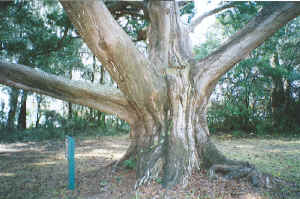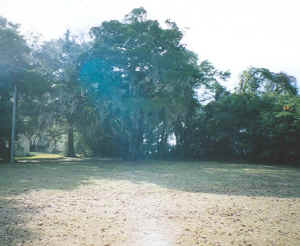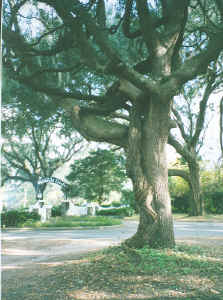Ents,
Over the holidays I attended a friend's wedding on St. Simons
Island
on the Georgia coast. To my surprise, I recognized the chapel
grounds. The avenue of Spanish moss draped live oaks could be
found
at many sites along the coast, but the presence of the state
champion
southern red cedar (Juniperus silicicola) confirmed the site as
the
one I remembered. The tree's massive spreading
limbs produce a
memorable image and support a broad crown with an undulating
upper
surface, similar to the adjacent Intercoastal Waterway on a
rough day.
That structure produces many tops of similar height, and several
of
those tops are laterally greatly displaced from the base, a
leading
cause of height errors. Contrastingly, the site offers excellent
measuring conditions; the ground is flat, and the open grounds
offer
completely unobscured views of the crown from multiple
directions.
While the tree definitely has a single stem, the branches emerge
low
enough to swell the trunk at 4.5', another source of potential
error.
|

Georgia Champion Southern Red Cedar 16'5" circumference at three feet above ground,
41.7' tall.
|

Georgia Champion Southern Red Cedar 16'5" circumference at three feet above ground,
41.7' tall. Previously measured as being 52' tall.
|
A plaque beside the tree states a local garden club (?) now
looks
after the tree's health, and declares the southern red cedar the
second largest in the state and second largest in the country.
The
national champion in Florida has only slightly more points, but
the
tree remains on the Georgia list as the state champion. The
plaque
also indicates the tree has been measured by foresters three
times:
first in 1976, once in the 1980's, and most recently in 2004.
The
dimensions listed on the plaque, presumably from the most recent
measurement, are 16.6' circumference, height 52', and spread
80'.
Measuring at the 3' high waist, I got a circumference of
16'5", pretty
close. However, the highest live top I could find was 41.1', and
a
recently killed top was 41.7'. Another top a foot higher might
be
hiding within the crown, but the height certainly does not
approach
52'.

At the same site, a 4'9" cbh grape vine growing on a live oak.
|
Even under these good conditions, purported experts failed
to
measure the tree's height accurately. A tape and clinometer
certainly
could have been used to accurately measure the tree's height; if
the
position on the ground below the high point were located,
dragging the
tape from that point would have yielded an accurate height. This
situation is another example showing that for a clinomter to
enable
accurate height measurements is not a sufficient condition for
accurate height measurements. In broad usage, people cannot be
assumed to use them correctly.
Jess Riddle
|